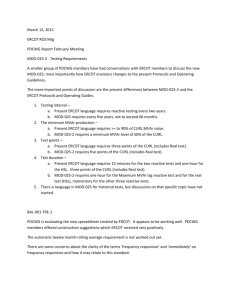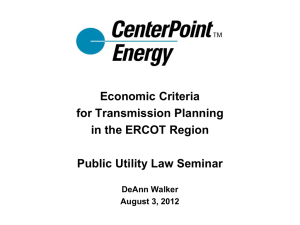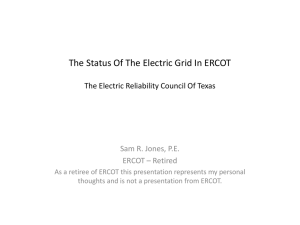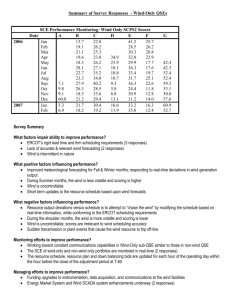Dynamic Ratings Project Description Document
advertisement
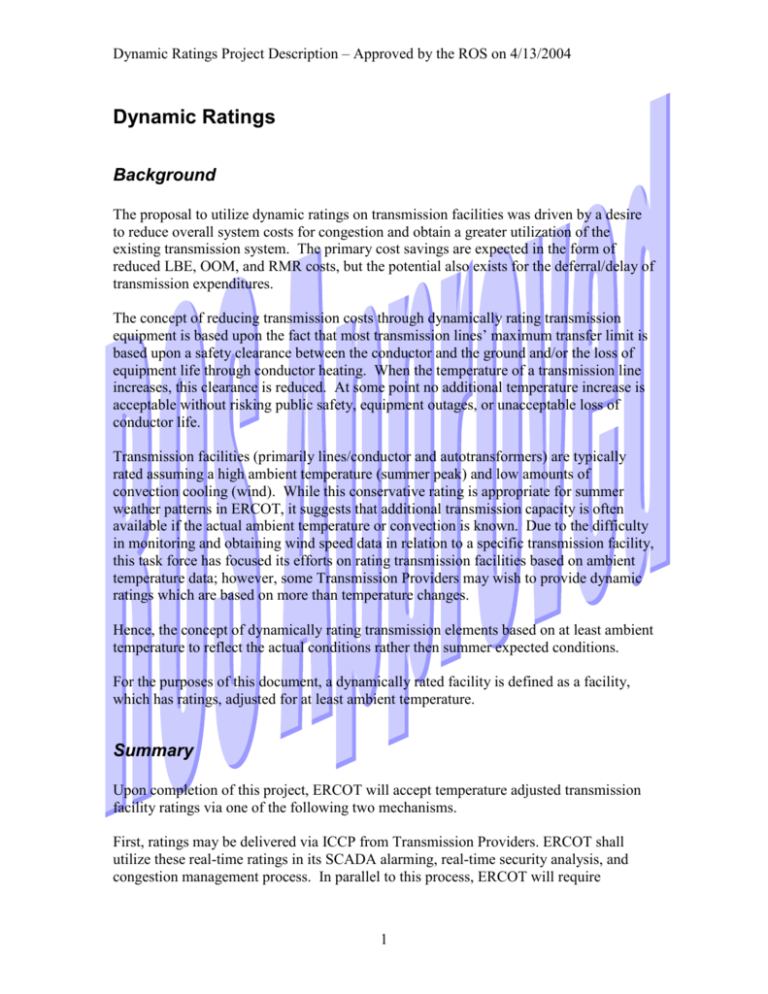
Dynamic Ratings Project Description – Approved by the ROS on 4/13/2004 Dynamic Ratings Background The proposal to utilize dynamic ratings on transmission facilities was driven by a desire to reduce overall system costs for congestion and obtain a greater utilization of the existing transmission system. The primary cost savings are expected in the form of reduced LBE, OOM, and RMR costs, but the potential also exists for the deferral/delay of transmission expenditures. The concept of reducing transmission costs through dynamically rating transmission equipment is based upon the fact that most transmission lines’ maximum transfer limit is based upon a safety clearance between the conductor and the ground and/or the loss of equipment life through conductor heating. When the temperature of a transmission line increases, this clearance is reduced. At some point no additional temperature increase is acceptable without risking public safety, equipment outages, or unacceptable loss of conductor life. Transmission facilities (primarily lines/conductor and autotransformers) are typically rated assuming a high ambient temperature (summer peak) and low amounts of convection cooling (wind). While this conservative rating is appropriate for summer weather patterns in ERCOT, it suggests that additional transmission capacity is often available if the actual ambient temperature or convection is known. Due to the difficulty in monitoring and obtaining wind speed data in relation to a specific transmission facility, this task force has focused its efforts on rating transmission facilities based on ambient temperature data; however, some Transmission Providers may wish to provide dynamic ratings which are based on more than temperature changes. Hence, the concept of dynamically rating transmission elements based on at least ambient temperature to reflect the actual conditions rather then summer expected conditions. For the purposes of this document, a dynamically rated facility is defined as a facility, which has ratings, adjusted for at least ambient temperature. Summary Upon completion of this project, ERCOT will accept temperature adjusted transmission facility ratings via one of the following two mechanisms. First, ratings may be delivered via ICCP from Transmission Providers. ERCOT shall utilize these real-time ratings in its SCADA alarming, real-time security analysis, and congestion management process. In parallel to this process, ERCOT will require 1 Dynamic Ratings Project Description – Approved by the ROS on 4/13/2004 Transmission Providers to submit a table of facility rating vs. temperature for use in operational planning studies. Second, Transmission Providers may alternatively elect to provide ERCOT with a table of equipment rating vs. temperature as well as a temperature value in real-time via telemetry for each weather zone spanned by the TDSP. ERCOT will use the table and temperature to determine the rating of each such designated facility. ERCOT will provide tools to implement either methodology on any subset of transmission facilities in the ERCOT transmission system. The tools will be sized to accept any number of dynamically rated pieces of facilities up to the total number of transmission elements (overhead lines, underground lines, and transformers) in ERCOT. ERCOT will be expected to identify transmission facilities that are causing significant congestion costs, and may require dynamic rating tables be provided by the Transmission Providers in a timely fashion. An initial response should be completed by the Transmission Provider in 30 calendar days. In special situations in which an element is causing significant congestion and the problem is expected to be seasonal (or shorter duration), then ERCOT may request that the required information submittal be expedited and that the Transmission Provider may incur additional costs to do so. The ERCOT market is expected to save a significant portion of the $390 Million/year currently expended to control congestion through this process. Real-Time Process Ratings via ICCP: The Transmission Provider will supply facility ID, From Station, To Station, Normal rating, Emergency rating and 15-minute rating via ICCP every 10 minutes. ERCOT will link each provided facility rating with the ERCOT network model and implement the ratings within 5 minutes of receipt. These ratings will be used in SCADA, real time contingency analysis, and real-time congestion management. Ratings via static table and telemetered temperature: ERCOT will define a set of tables implementing the temperature characteristics provided by the transmission provider for selected transmission facilities, including line ID, From Station, To Station, weather zone, transmission provider and each of the three limits: Normal, Emergency, and 15-minute. The appropriate Transmission Service Provider will provide ERCOT with temperature/rating data points describing the rating of the selected equipment at 10-degree1 intervals. 1 ERCOT shall procure software capable of defining these tables at alternative temperature divisions, allowing the temperature/rating samples to be changed to alternative spacing (such as 15 degrees, or 20 degrees) in the future. 2 Dynamic Ratings Project Description – Approved by the ROS on 4/13/2004 ERCOT will link each transmission facility defined in these tables to one telemetry point with the current temperature provided by the Transmission Provider. The Transmission Provider shall provide a current temperature for each weather zone it spans. The transmission provider will update the current temperature at least every 10 minutes. ERCOT will apply the appropriate rating based upon this temperature by interpolating between temperature/rating points to update the continuous, emergency and 15-minute rating within 5 minutes of receipt of the real time temperature. These ratings will be used in SCADA, real time contingency analysis, and real-time congestion management. Daily Process Each day prior to 17:00 the Transmission Provider will provide electronically via ICCP or telemetry, the hourly temperatures for each zone to be used for calculating CSC limits the next day, or shall alternatively provide instructions directing ERCOT to use its forecast temperature for the appropriate zone, plus a constant “safety factor” to be designated by the TSP. Alternatively, the transmission provider may provide via ICCP a dynamic rating for each line being dynamically rated in place of the forecast temperature. 3 Dynamic Ratings Project Description – Approved by the ROS on 4/13/2004 Transmission Provider tells ERCOT what Temperature to use for each Weather zone in Real-time North North Central Far West We st South Centr al South Transmissi on Provider 4 East Coast Dynamic Ratings Project Description – Approved by the ROS on 4/13/2004 Communications Recommended data transfer mechanisms. I. Real time telemetry of temperature for each weather zone: a. Transfer to Ercot via ICCP Block 1 (periodic) or Block 2 (by exception) or via RTU. II. Next day hourly temperature for each weather zone: a. Transfer to ERCOT via ICCP Block 8 (Transfer Account) as 24 values in a one dimensional array for each weather zone updated daily prior to 17:00 b. As an alternate the Transmission provider can opt to have ERCOT use it’s weather forecast data for each zone. III. Table of ratings by temperature: a. Transfer a table to ERCOT via ICCP Block 8 (Transfer Account) as a 2 dimensional array with the columns representing Line ID, From Station, To Station, Weather Zone, Transmission Provider, Normal Limit; Emergency Limit; 15 Minute Limit. This information to be provided from xx degrees to yy degrees in 5 degree increments. Dynamic Rating Service Requests ERCOT will implement a service request process by which Transmission Providers shall provide the dynamic rating table described above to ERCOT electronically. ERCOT will provide software to validate the provider via digital certificates, log the data provided and provider, and implement the new dynamic rating automatically within 24 hours. ERCOT responsibilities ERCOT will: Provide software to accept and implement dynamic ratings or temperatures to be applied to rating tables in real-time. Provide software and processes to implement these dynamic ratings as described above. Use these ratings for alarming, compliance with ERCOT and NERC requirements, and congestion management purposes in both real-time and operational planning. Identify additional transmission elements which have a high probability of providing significant added economic efficiency to the ERCOT market through dynamic rating and request dynamic ratings from the associated transmission provider. 5 Dynamic Ratings Project Description – Approved by the ROS on 4/13/2004 In cases identified by the TSP as crossing weather zones, shall receive and track a designation from the appropriate TSP which weather zone forecast to use in dynamically rating the line; or at the option of the TSP shall adopt the most restrictive temperature. In cases of jointly owned lines, shall calculate the minimum temperature/rating combination from two sets of data provided by the two owners and apply the minimum rating calculated. Transmission Provider Responsibilities Transmission Service Providers will: Provide ERCOT with tables of ratings for different ambient temperatures as requested by ERCOT. Each request by ERCOT for a new table will result in an initial submittal within 30 calendar days unless multiple requests are made by ERCOT within the 30 calendar day period. Provide real-time temperatures for each zone in which the Transmission Provider has existing dynamically rated transmission equipment or alternatively provide rating updates for each dynamically rated facility, each with a maximum of 10 minute update periodicity. Provide prior to 17:00, via ICCP, next day hourly temperature forecasts for each zone in which the Transmission Service Provider has dynamically rated transmission facilities to be used in CSC limit calculations; or have on file with ERCOT directions instructing ERCOT to use the ERCOT weather forecast plus a constant (safety factor) to be provided by the requesting Transmission Service Provider. (Note – These directions must be approved by ERCOT legal department limiting ERCOT liability in good faith usage) If “safety factors” are specified by Transmission providers as described above, ERCOT shall post this information for market participants. ERCOT shall post dynamic ratings used to market participants. (Note – This does not require that ERCOT save every rating used every hour). The ratings may be the same for the full temperature range for some facilities. 6


